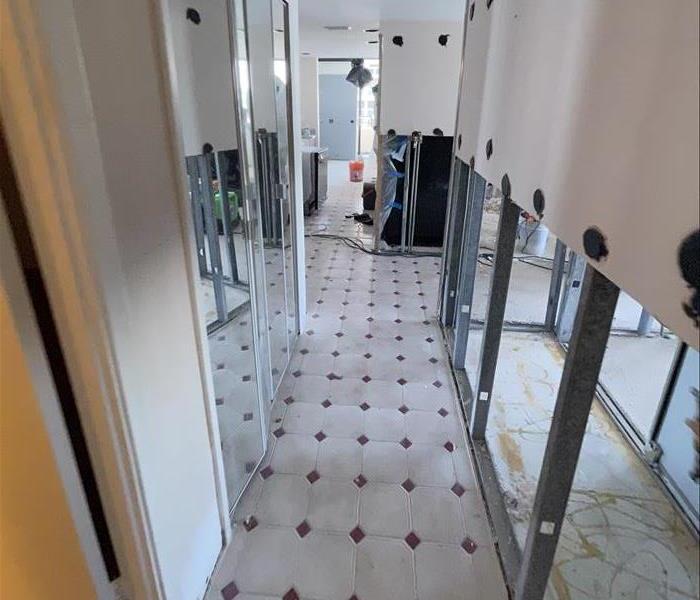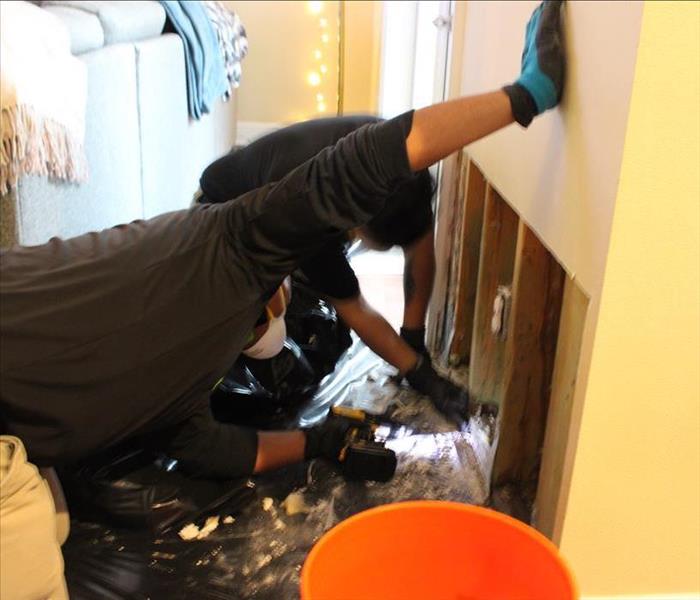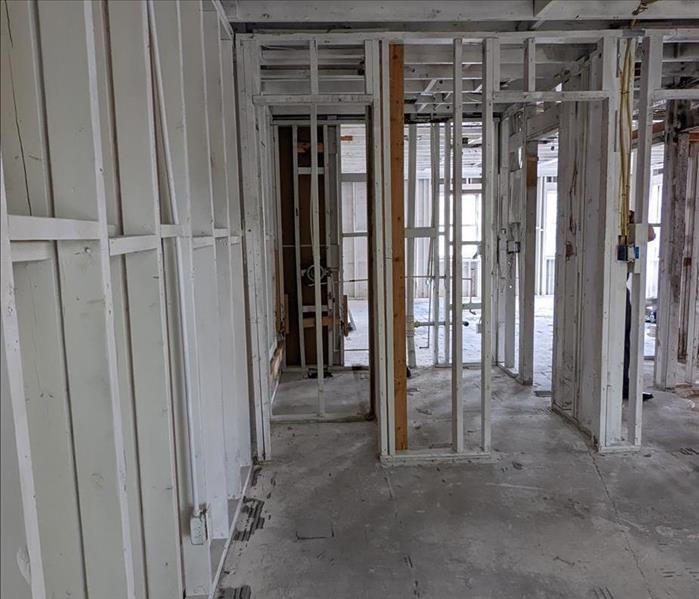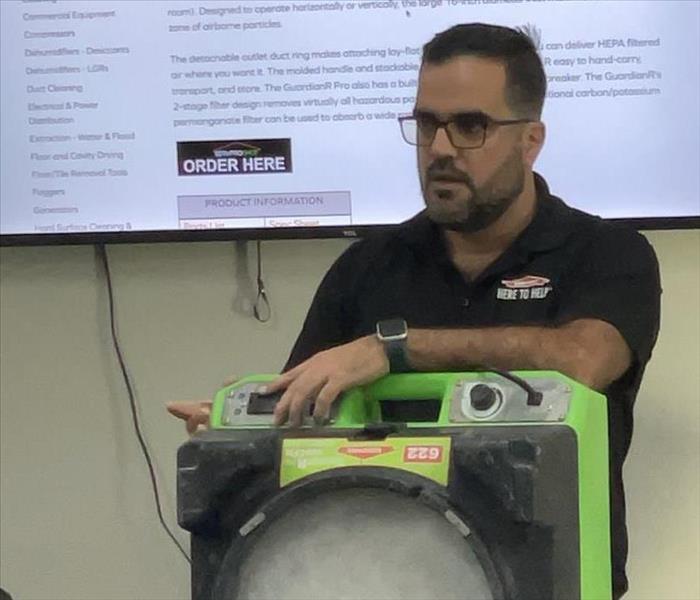Recent Posts
Mold in Schools: Risks and Prevention Measures
7/17/2024 (Permalink)
When it comes to ensuring a safe and conducive learning environment for students, preventing mold growth in schools is crucial. Mold can cause structural damage and lead to costly repairs, disrupting the educational process. At SERVPRO®, we understand the importance of maintaining a clean and safe school environment. In this blog post, we will explore the risks associated with mold in schools and provide effective prevention measures.
Understanding Mold Growth in Schools
Mold is a type of fungus that thrives in damp, warm, and humid environments. Schools, with their complex systems of classrooms, bathrooms, kitchens, and basements, can be particularly vulnerable to mold growth if not properly maintained. Common places where mold can be found include:
- Basements and Crawl Spaces: These areas are prone to moisture accumulation, making them ideal breeding grounds for mold.
- Bathrooms and Locker Rooms: High humidity levels in these areas provide the perfect environment for mold to thrive.
- Kitchens and Cafeterias: Spills and leaks, combined with the warmth from cooking appliances, can lead to mold growth if not promptly addressed.
- Classrooms with Poor Ventilation: Rooms without adequate air circulation can trap moisture, promoting mold development.
Risks of Mold in Schools
While mold itself is a natural part of the environment, its presence in schools can lead to significant problems. Mold can damage building materials, leading to the deterioration of walls, ceilings, and floors. This damage can result in expensive repairs and potential closures of affected areas, disrupting the learning process and school activities. Additionally, mold can impact the integrity of school facilities, causing long-term structural issues.
Prevention Measures
Preventing mold growth in schools involves a proactive approach and regular maintenance. Here are some effective prevention measures:
- Control Humidity Levels: Keep indoor humidity levels below 60%. Use dehumidifiers in areas prone to moisture and ensure proper ventilation in all rooms, especially in bathrooms, kitchens, and locker rooms.
- Fix Leaks Promptly: Address any leaks in roofs, walls, or plumbing systems immediately. Regularly inspect these areas for signs of water damage and repair any issues without delay.
- Improve Ventilation: Ensure that all areas of the school have adequate ventilation. Install exhaust fans in high-moisture areas such as bathrooms and kitchens, and ensure that HVAC systems are functioning correctly and efficiently.
- Regular Inspections and Maintenance: Conduct routine inspections of the school premises to identify and address any signs of mold or moisture problems. Regular maintenance of roofs, plumbing, and HVAC systems is essential to prevent mold growth.
- Clean and Dry Areas Promptly: In the event of spills or water intrusions, clean and dry affected areas immediately. Mold can begin to grow within 24-48 hours, so prompt action is critical.
- Use Mold-Resistant Products: When renovating or constructing new areas, consider using mold-resistant materials such as drywall and paint to reduce the risk of mold growth.
Preventing mold in schools is essential for maintaining a safe and functional learning environment. By implementing these prevention measures and regularly monitoring the school premises, administrators can significantly reduce the risk of mold growth and the associated damage. At SERVPRO, we are committed to helping schools maintain clean and mold-free environments. If you suspect mold in your school, contact us for professional assessment and remediation services. Our team of experts is ready to restore your school to a safe and welcoming space for students and staff.
How to Recover from Water Damage: A Step-by-Step Guide
6/12/2024 (Permalink)
 Once the area is clean and dry, it's time to begin the restoration process.
Once the area is clean and dry, it's time to begin the restoration process.
Water damage can be a stressful and overwhelming experience for homeowners, but knowing how to recover from it effectively can make the process smoother and more manageable. In this guide, we'll walk you through the steps to take to recover from water damage and restore your home to its preloss condition.
Stop the Source
If the water damage is due to a leak or burst pipe, the first step is to stop the source of water. Shut off the main water supply to your home to prevent further flooding and damage. If the water damage is due to a natural disaster or external source, focus on securing the property and minimizing additional water intrusion.
Assess the Damage
The next step in recovering from water damage is to assess the extent of the damage. Take stock of affected areas and items, including walls, floors, furniture, and personal belongings. Identify any safety hazards such as electrical issues or structural damage and prioritize addressing them.
Remove Standing Water
Once the source of water has been stopped, begin removing standing water from the affected areas. Use buckets, mops, or wet vacuums to extract water from floors and surfaces. Open windows and doors to promote airflow and aid in the drying process.
Dry Out the Area
Proper drying is essential to prevent mold growth and further damage. Use fans, dehumidifiers, and air movers to circulate air and speed up the drying process. Thoroughly dry affected areas, including walls, floors, and furniture, to prevent moisture from lingering and causing additional problems.
Clean and Disinfect
After drying out the area, it's important to clean and disinfect surfaces to remove any contaminants and prevent mold growth. Use a mild detergent and water solution to clean affected surfaces, and then apply a disinfectant to kill any remaining bacteria or mold spores.
Restore and Repair
Once the area is clean and dry, it's time to begin the restoration process. Repair or replace damaged materials such as drywall, insulation, flooring, and furniture as needed. Work with professional restoration experts like SERVPRO® to ensure that repairs are done correctly and safely.
Monitor for Mold
Even after water damage has been addressed, it's important to monitor the affected areas for signs of mold growth. Keep an eye out for musty odors, discolored patches on walls or ceilings, or visible mold growth. If mold is present, take steps to address it promptly to prevent further damage and other risks.
Consult with Professionals
Throughout the recovery process, don't hesitate to seek help and guidance from professional restoration experts. Companies like SERVPRO of South Orlando have the experience, expertise, and resources to handle water damage restoration safely and effectively, ensuring that your home is restored to its preloss condition as quickly as possible.
Recovering from water damage can be a challenging process, but by following these steps and working with trusted professionals, you can successfully restore your home and move forward with peace of mind. If you need assistance with water damage restoration, don't hesitate to reach out to our SERVPRO team for help.
Unveiling Hidden Storm Damage: What to Look For
5/16/2024 (Permalink)
 Excess moisture from storm damage can create ideal conditions for mold and mildew growth.
Excess moisture from storm damage can create ideal conditions for mold and mildew growth.
After a severe storm passes through your area, it's essential to assess your property for any signs of damage, both apparent and hidden. While some damage may be obvious, such as broken windows or fallen trees, other issues can lurk beneath the surface and go unnoticed until they become more severe. Here are some key indicators to help you recognize hidden storm damage:
Inspect Your Roof
Start by carefully examining your roof for any signs of damage, such as missing or damaged shingles, cracks, or dents. Pay close attention to areas where different roof surfaces meet, as these are common spots for leaks to develop.
Check Gutters and Downspouts
Gutters and downspouts play a crucial role in directing water away from your home. After a storm, inspect them for clogs, damage, or detachment from the roofline. Improper drainage can lead to water leaks and structural damage over time.
Look for Water Stains
Water stains on ceilings, walls, or around windows can indicate leaks or water intrusion. Even small stains should be investigated further, as they could be a sign of more extensive damage hidden behind the surface.
Examine Exterior Siding
Inspect the exterior siding of your home for cracks, chips, or warping caused by wind or flying debris. Damaged siding can compromise the integrity of your home's envelope and lead to moisture problems if not addressed promptly.
Check for Foundation Issues
Walk around the perimeter of your home and inspect the foundation for any signs of cracks or shifting. Even hairline cracks can indicate underlying structural issues that need to be addressed to prevent further damage.
Assess Landscaping
Fallen branches, uprooted trees, or displaced landscaping elements can pose safety hazards and cause damage to your property. Clear away any debris and assess the health of your trees to prevent potential hazards during future storms.
Monitor for Mold and Mildew
Excess moisture from storm damage can create ideal conditions for mold and mildew growth. Keep an eye out for musty odors, dampness, or visible signs of mold in areas prone to water damage, such as basements, attics, and crawl spaces.
By being vigilant and conducting a thorough inspection of your property after a storm, you can identify hidden damage early and take the necessary steps to address it before it worsens. Remember that safety should always be a priority, so if you're unsure about the extent of the damage or how to address it, don't hesitate to seek professional assistance.
Safe Ash and Debris Cleanup After a Fire
4/15/2024 (Permalink)
 Our trained technicians have the expertise and equipment to safely and effectively clean up and restore fire-damaged buildings.
Our trained technicians have the expertise and equipment to safely and effectively clean up and restore fire-damaged buildings.
When a fire ravages a building, the aftermath can be overwhelming, with ash and debris covering every surface. It's essential to approach the cleanup process with caution and care to ensure safety and thoroughness. In this blog post, we'll provide you with practical tips on how to safely clean up ash and debris from burned buildings, helping you navigate the restoration process with confidence and efficiency.
- Assess the Damage
Before beginning cleanup efforts, assess the extent of the damage to determine the scope of the cleanup and restoration needed. Take note of any structural damage, hazards, or areas of concern that may require professional assistance.
- Protect Yourself
Prioritize safety by wearing appropriate personal protective equipment (PPE), including gloves, goggles, and respiratory protection, to shield yourself from potential hazards such as ash, soot, and airborne contaminants.
- Ventilate the Area
Open windows and doors to promote ventilation and improve air quality within the building. Use fans or air purifiers to help circulate fresh air and remove lingering smoke odors.
- Remove Loose Debris
Begin by carefully removing loose ash and debris from surfaces using a broom, dustpan, or vacuum cleaner equipped with a HEPA filter. Avoid using household vacuums, as they may spread fine particles and contaminants.
- Clean Surfaces
Clean surfaces thoroughly using a mild detergent or cleaning solution and warm water. Use a sponge or cloth to scrub surfaces gently, focusing on areas heavily affected by ash and soot buildup. Rinse with clean water and allow surfaces to air dry.
- Dispose of Debris Properly
Bag and seal ash and debris in sturdy trash bags, double-bagging if necessary, to prevent dust and contaminants from escaping. Dispose of bags in accordance with local regulations and guidelines for handling fire debris.
- Monitor Air Quality
Use air quality monitors to assess indoor air quality and ensure that airborne contaminants are adequately controlled during cleanup. Consider hiring professionals to conduct air quality testing for thorough assessment and peace of mind.
- Seek Professional Assistance
For extensive fire damage or areas that pose safety risks, such as structural instability or hazardous materials, enlist the help of professional restoration experts like SERVPRO of South Orlando. Our trained technicians have the expertise and equipment to safely and effectively clean up and restore fire-damaged buildings.
By following these steps and prioritizing safety, you can navigate the cleanup process effectively and restore your property to a safe and habitable condition after a fire. If you require assistance with fire damage cleanup and restoration, don't hesitate to contact SERVPRO® for prompt and reliable service.
Laborer to Production Operations Manager - Celebrating Success, Mentorship, and Team Spirit at SERVPRO® of South Orlando
12/6/2023 (Permalink)
 Heydrich Kattar Hernandez training his SERVPRO Team
Heydrich Kattar Hernandez training his SERVPRO Team
In his 2 short years with SERVPRO® Team Nicholson, representing our Orlando location, Heydrich Kattar Hernández has proved endless in zeal, integrity, and a desire for personal and professional development. As we celebrate having Heydrich on board, we not only commemorate his individual successes but also the mentorship and inspiration he offers to our entire team.
In November 2021, Heydrich started with us as a laborer, bringing enthusiasm and an eagerness to learn. His tenure has been marked by significant, quick growth, shaped by his willingness to serve in a variety of roles. He says the diverse experiences—from working on various residential and commercial jobs to the challenges of long hours and extensive travel—have enriched his professional journey.
Now serving as Production Operations Manager within our Training Division, Heydrich continues offering a high standard of service as he uses his passion for making a meaningful impact on our customers’ and employees’ lives. He says, "I've had the privilege of meeting people from all walks of life and contributing to helping others in their homes."
Heydrich embodies the SERVPRO Team Nicholson culture that values knowledge-sharing, encouragement, and opportunity. He says,
“I am sincerely thankful for the belief placed in me, the opportunities to share knowledge, and the continuous support from colleagues who have been mentors and guides. Special appreciation goes to those who have dedicated time to teach, coach, or offer support.“
Heydrich's journey with SERVPRO of South Orlando and SERVPRO Team Nicholson not only marks a personal achievement, but serves as a testament to the power of teamwork and constancy.
Today, Heydrich is excited about the future as he focuses on scouting for talent that aligns with our core values, and continues to help our team grow and improve. Cheers to Heydrich!
Follow the story on our LinkedIn.
The Power of Master Service Agreements: Fast Response and Strong Relationships
9/18/2023 (Permalink)
Do you have a super hero on speed dial? In the fast-paced world of business, rapid response is essential, especially during emergencies. Picture this: a national heatwave causes an abrupt A/C outage, with the potential to turn a hospital into an oven of stress and panic. In times like these, having a Master Service Agreement (MSA) in place can be the lifeline that transforms panic into a strategic, well-managed solution.A Race Against Time
SERVPRO® Team Nicholson's Scott Askew and his crew proved the power of an MSA recently. Within hours of receiving the call, our team was on-site, ready to help. Seven hours later, cooling equipment was up and running - thanks to our subcontractor, Coastal Mechanical. We even had a team of welders fabricating quick hose connections in the hospital parking lot in order to connect the mobile chillers to the hospital's existing cooling system.
By the evening, the hospital was cooling to a comfortable temperature, all without displacing patients or disrupting critical operations. The team avoided an evacuation and multiple diversions, where a hospital has to transfer patients to another hospital. In the end, all this was possible without having to tell an MSA client, "no," — the word doesn't exist in our vocabulary anyways.
Building a Bridge to Swift Solutions
The MSA is more than just a contract - we become your logistics team, your trusted solutions provider. The last thing a business owner wants is to face a double emergency – the primary situation and its repercussions. Like the scramble to evacuate patients, and to secure specialized equipment, like chillers, at odd hours in order to prevent high temperatures from spoiling medication. An MSA eliminates the chaos, minimizing the complexity and severity of interruptions to business.
The Value of Strong Relationships
In the realm of crisis management, strong relationships are worth their weight in gold. Our connections with clients, subcontractor partnerships, and a network of SERVPRO teams across the nation, our bonds serve as the cornerstone of effective and efficient solutions. When challenges arise, leveraging our network's capabilities means clients have access to additional equipment and resources quickly.
In a world of emergencies, a Master Service Agreement isn't just a contract – it's a promise - to provide rapid response, leverage strong relationships, and transform potential chaos into smoothly managed solutions. It's the assurance that when a crisis arises, our team of professionals is ready to shift the perspective - becoming your total solutions provider for whatever happens.
Protecting What Matters: The Emergency Plan Every Parent Needs Before School Starts
8/8/2023 (Permalink)
 Does your child know what to do?
Does your child know what to do?
Do You Have a Back-to-School Family Emergency Plan?
No one likes to think that an emergency could happen to them, but the reality is that disaster can happen anytime, anywhere, including while your child is at school.
Even if you never end up needing your family emergency plan, it's best to be prepared—just in case. Having a detailed plan in place will give you everyday peace of mind, and—in the event of an emergency—could save lives.
Emergency Contacts
List 1-3 trusted emergency contacts who can pick up your child from school if you are unable to do so.
Confirm their availability and willingness to be emergency contacts.
Teach your child how to contact each person by phone.
Familiarize your child with each contact's appearance and vehicle.
Communicate with the School
Keep school up-to-date with who is allowed to pick your child up.
Provide correct contact information and identification for their records.
Inquire about the school's policies for emergency situations and designated pick-up areas.
Alternative Drop-Off Locations
Establish an alternative drop-off location in case emergency contacts cannot be reached promptly.
This location could be a trusted friend or family member's house, or another secure spot.
Familiarize your child with the alternate location's address and phone number to accurately guide authorities there.
Re-Evaluate Each Year
As your child ages, changes schools, or your family moves, it's smart to update your plan annually.
Although we hope your family never experiences an unexpected disaster, if you do, SERVPRO® is available 24/7/365 for emergency service. Learn more here. Your family's safety and preparedness are paramount, and having a well-structured emergency plan is a crucial step in ensuring their protection.
SERVPRO of South Orlando are Cleaning Experts
7/24/2023 (Permalink)
SERVPRO of South Orlando is Here to Help
During unprecedented times caused by the global pandemic, our customers remind our customers that we are specialists in cleaning services. We adhere to the highest cleaning and sanitation standards.
Specialized Training
The Centers for Disease Control and Prevention (CDC) set forth protocols, SERVPRO of South Orlando is prepared to clean and disinfect your home or business. We have years of experience in dealing with biological contaminants, and we will go beyond the scope of work that regular janitorial staff performs daily.
The CDC encourages cleaning high-touch surfaces such as counters, tabletops, doorknobs, light switches, bathroom fixtures, toilets, phones, keyboards, tablets, and tables. Other spaces mentioned in the CDC's guidance for commercial spaces include:
- Kitchen/Food Areas
- Bathrooms
- Schools/Classrooms
- Offices
- Retail Spaces
- Water Fountains
- Shelving/Racks
- Sales Counters
- Carpets and Rugs
- Stair Handrails
- Elevator Cars
- Playground Equipment
- Fitness Equipment
- Specialized Products
The CDC recommends the usage of a labeled hospital-grade disinfectant with claims against similar pathogens to the coronavirus. Multiple products in the SERVPRO product line carry the EPA-approved emerging pathogens claims. While there's currently no product tested against this particular strain of the coronavirus, we follow all CDC and local authorities' guidelines.
Do you need proactive cleaning of your commercial property? Call SERVPRO of South Orlando today at 407-985-3200.
Smoke Residue Can Accumulate after Fire Damage to Your Edgewood Home
7/24/2023 (Permalink)
Rely on SERVPRO for Professional Fire Damage Restoration
An incidence of fire damage can cost you a ton of money and time to restore. The ability to restore depends on the extent of damage caused by the flames and the smoke and soot residue. Smoke and soot particles are one of the most significant contributors when it comes to fire damage to your Edgewood home. Not all fires produce identical residue, and the time and effort required to clean these different residue types determine the success of the restoration process. IICRC certified SERVPRO technicians use their extensive knowledge about different types of residue during the restoration process. While some residues have a minor impact, some others can cause more profound damage.
Dry and Wet Residue
Frequently encountered residue after a fire incident includes wet and dry residues. All fires produce both these residues, but their relative proportion can vary greatly. For instance, a rapid burning fire that has an abundant supply of oxygen usually produces dry residues. On the other hand, if the fire was slow-burning with less than optimal oxygen supply, the wet residue is formed mostly.
Another thing affecting residue generated is material burning. While natural materials such as wood and cotton result in drier smoke residue, synthetic materials such as rubber and plastic produce wetter smoke. As it turns out, drier residues are easier to clean compared to wetter residues. SERVPRO technicians can use less harsh techniques such as cleaning with a sponge to clean the damage due to drier smoke, but wet residues often require more intense cleaning processes.
Protein Residue
Protein residue is quite common if a fire breaks out in the kitchen. The burning of meat, poultry, or fish usually generates this type of residue. It's pale yellow and can stain surfaces quite easily. It's also accompanied by the characteristic odor that can linger on for a long time. Odor removal cannot occur without a thorough cleaning process followed by an efficient deodorization. Protein residue can be quite challenging to stop, and the restoration process may require additional time.
Call SERVPRO of South Orlando at (407) 985-3200 today to schedule a free consultation with one of our restoration experts.
When and Where Do Hurricanes Likely Occur?
7/12/2023 (Permalink)
Hurricane season in the Atlantic runs from June 1st to November 30th. However, storms outside of these dates are not unheard of. Activity ramps up in August and peaks in early September, then again in October.
Hurricanes form this season because of two factors: warm ocean waters (80 degrees or higher) and weak vertical winds (little change in wind direction and/or speed with height) are most common. This is also the season with the highest frequency of west-moving weather disturbances in the tropics that eventually develop into hurricanes.
The only difference between a hurricane, cyclone, and typhoon in your location. People in our area refer to violent thunderstorms as hurricanes, while people near the equator, Africa and Australia, refer to them as cyclones.
If your property experiences damages from a hurricane, SERVPRO of South Orlando is Here to Help. Call today at (407) 985-3200.




 24/7 Emergency Service
24/7 Emergency Service


